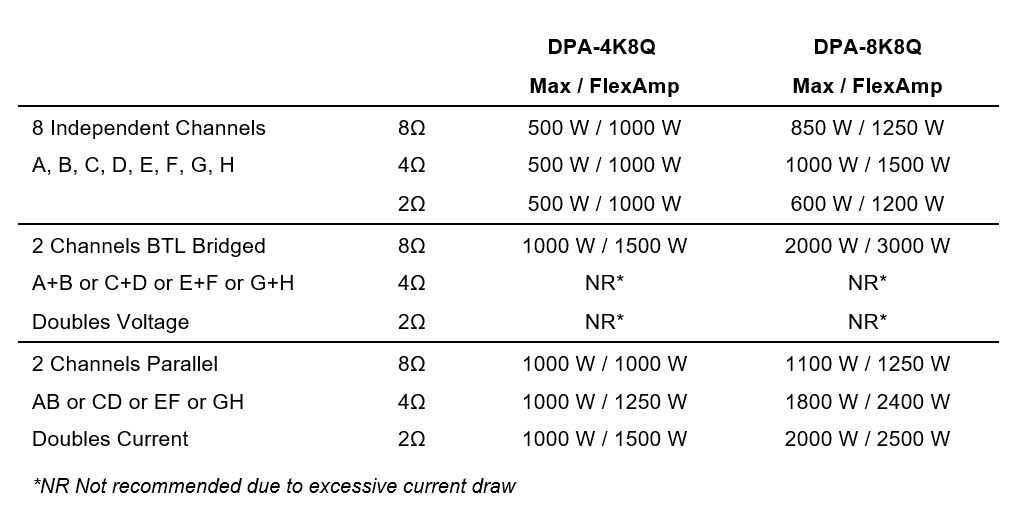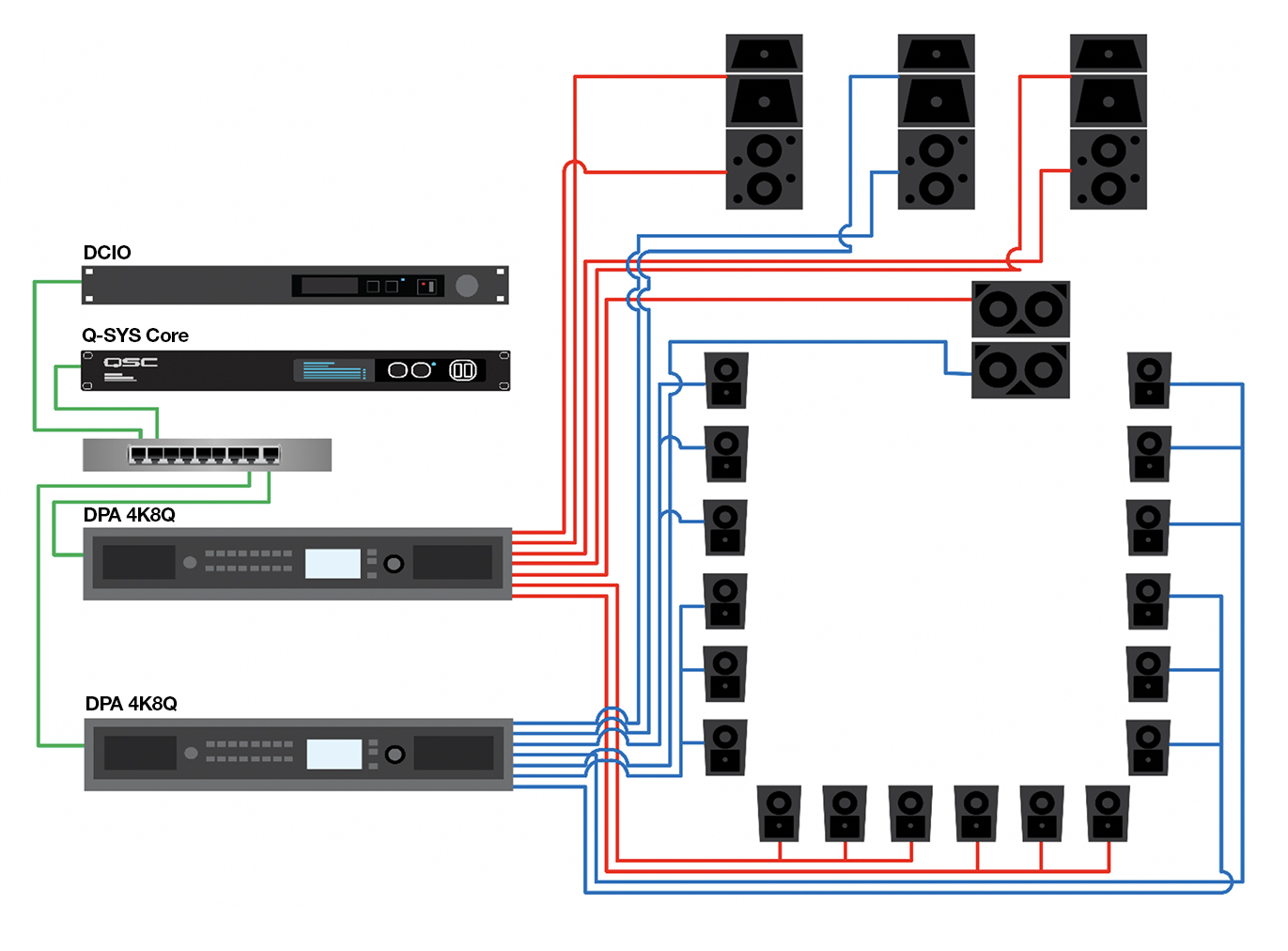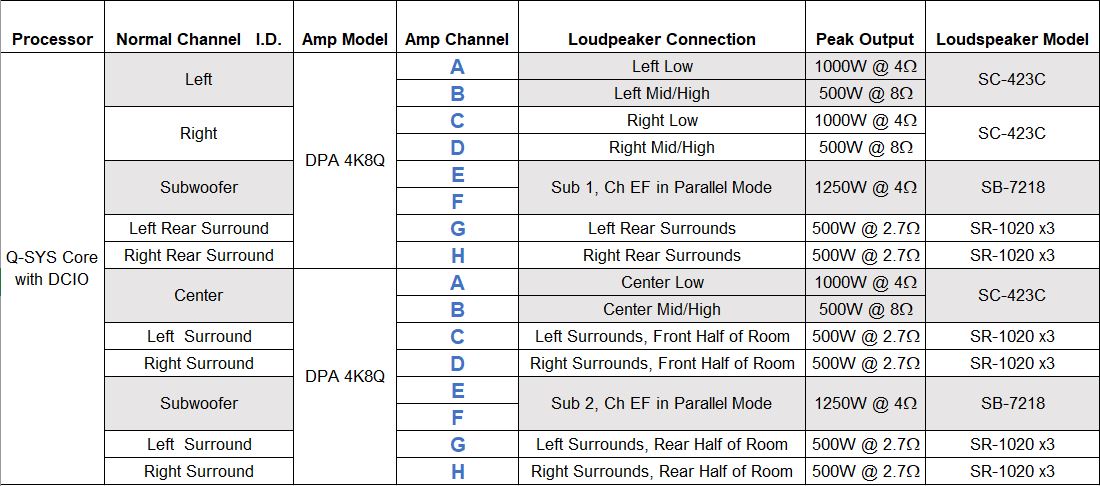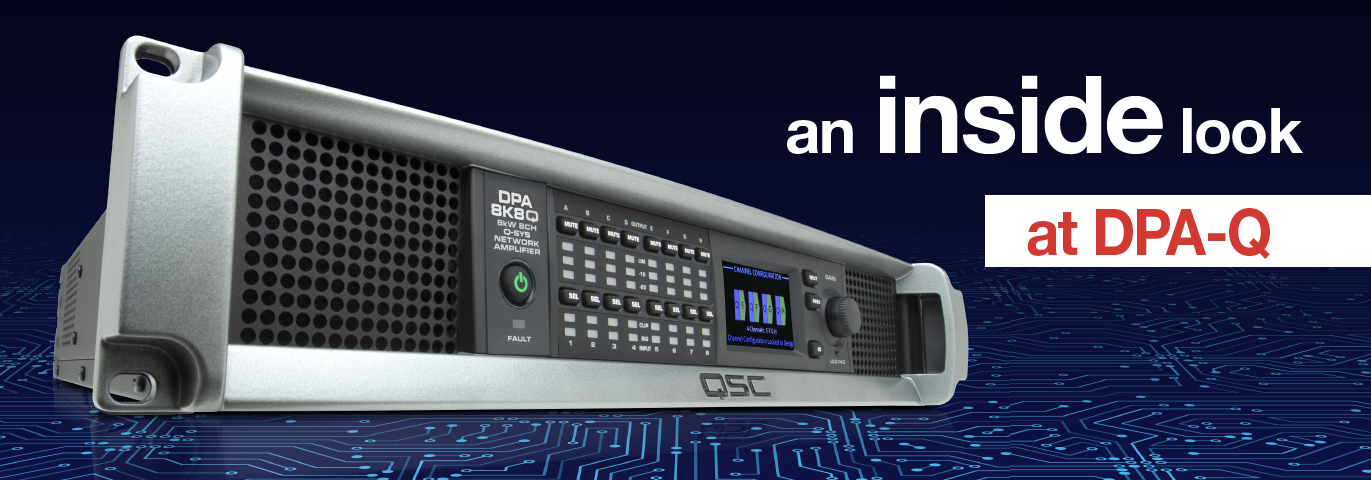Discover the power and flexibility of the new DPA-Q amplifier series
Q-SYS – our ecosystem for audio, video, and control – combined with our new DPA-Q amps, has become increasingly popular for powering immersive audio systems in Premium Large Format cinemas. In this post, we’ll show you how you can use our new 8-channel DPA-Q amplifiers to provide optimum power for our Digital Cinema Series loudspeakers even in 7.1 cinema applications, providing greater system flexibility and reduced cost.
DPA-Q Series network amplifiers combine two technologies that provide extreme flexibility in output deployment. FlexAmp™ allows for asymmetric output channel loading by drawing from large power reserves and distributing customized output power levels per channel. This can be especially useful for screen channel speakers, delivering more power to the LF section compared to the higher efficiency HF section, and for immersive surround speakers, delivering more power to the object-based speakers that demand it during soundtrack playback. FAST (Flexible Amplifier Summing Technology™) allows channels to be combined in bridge mode, parallel mode or bridge/parallel mode to deliver either higher voltage loads (up to 200 Vrms output) or higher current loads (up to 35 A).
Why is this important?
Cinema soundtracks are different from live music applications because they have high peak power demands, but low average power. Cinema program material ranges from soft dialog to loud special effects, but the average content is not very demanding, at least not long duration. DPA-Q amps are perfectly designed to take advantage of this. With high voltage DC rails, large peaks can easily pass without clipping. The DPA-Q power supply stores energy to deliver the high current required by those peaks from internal reservoirs (capacitors), thereby smoothing out and reducing the demand on AC power supplies.
Bridging amplifier channels has been available on amps for decades as a way to increase power. However, bridging doubles the voltage but does nothing to increase output current.
DPA-Q amps also offer paralleling of amp channels to double the current capacity into 2 and 4-ohm loads because parallel mode is superior to bridging for delivering maximum power into these loads. Bridging should be reserved for 8-ohm or higher loads.
At 155 Vdc, the single channel voltage rails of DPA-Q amps are already as high as many bridged amplifiers, so DPA-Q amps are rarely limited by output voltage in cinema applications. A commonly available 32-channel amplifier has 84 V rails that bridge to 168 V – not significantly more than a single unbridged channel of DPA-Q amps, and you don’t lose half of your channel count in the process.
In the power chart below, you can see that each channel of the DPA 4K8Q could deliver twice the power when the amp is not heavily loaded on all channels; 1000 W vs. 500 W for all channels driven.

A complete solution
By now it should be easy to see how using DPA-Q 8-channel amps and Q-SYS offers new, more efficient and flexible ways of powering typical 7.1 systems.
The QSC Digital Cinema I/O (DCIO) has all of the connectors you usually find on a standard cinema processor, and serves as the primary interface into the Q-SYS Ecosystem. Unlike single-purpose cinema processors, Q-SYS offers extensive signal processing and routing options, and integrates a sophisticated control system with the ability to create user-defined Graphical User Interfaces and to automate features with powerful scripting capabilities. You can see how these powerful capabilities offer many new ways to think about powering, monitoring and operating your multiplex.
What if you could…
- Power typical 7.1 rooms with just a pair of amplifiers that take up only 4 RU (7 inches) of rack space. In many cases, the sound system could go in the projector base to completely eliminate the cost of a separate sound rack.
- Use one model of amplifier almost everywhere and still have it tailored to the power requirements of your speakers. Ordering amps and stocking spares is easier when all you need is, for example, the DPA 4K8Q.
- Keep cost under control. A pair of DPA 4K8Q amps with 16 amp channels is close to the price of only 12 amp channels of our DCA amps of similar power.
- Control “boothless” systems from anywhere in the multiplex. Q-SYS eliminates the need to go into the booth to control and monitor the sound system. User-definable control GUIs can be accessed via an iOS device running on Wi-Fi or with a QSC Ethernet Touchpanel; or your own PC.
- Create a redundant system that keeps the show running. With the proper amp and speaker configuration, you can create “bypass” modes that keep you on screen if either of the two DPA 4K8Q amps should ever fail. (We will look at suggested configurations for bypass modes in another article.) Q-SYS supports redundant networks and redundant Core processors for even more “insurance”.


Q-SYS is the most powerful processing and control platform for Cinema, and DPA-Q amps are the most flexible and powerful amplifiers available. Now is the time to ask what Q-SYS can do for you. More often than not, the answer with Q-SYS is “Yes it can!
QSC Cinema Application Engineers are always ready to help with your specific Q-SYS and cinema system design needs. You may also want to take advantage of online Q-SYS training specifically geared for Cinema.

395050 607190You need to indulge in a contest for among the greatest blogs over the internet. Ill suggest this internet site! 829081
188437 992966This kind of lovely blog youve, glad I discovered it!?? 856954
Я очень доволен, что прочитал эту статью. Она не только предоставила мне интересные факты, но и вызвала новые мысли и идеи. Очень вдохновляющая работа, которая оставляет след в моей памяти!
Hi there I am so delighted I found your webpage, I really found you by mistake, while I was browsing on Bing for something else, Anyways I am here now and would just like to say kudos for a remarkable post and a all round entertaining blog (I also love the theme/design), I don’t have time to look over it all at the moment but I have book-marked it and also added in your RSS feeds, so when I have time I will be back to read much more, Please do keep up the great work.
prostitutes in Brasilia
กำลังมองหา รับเหมาสร้างบ้าน
ราคาถูก สำหรับผู้ที่ต้องการควบคุมงบ โดยเปรียบเทียบราคาบ้าน เลือกผู้รับเหมารายย่อย และวางแผนค่าใช้จ่ายสร้างบ้านให้เหมาะสม
It’s awesome to go to see this web page and reading the views of all colleagues regarding this post, while I am also eager of getting knowledge.
https://icw19.telkomnika.com/blog/2025/12/24/tout-savoir-sur-atlas-pro-sur-smart-tv-et-son-utilisation-pratique/
روند سفارش در سایت گرافیسو خیلی راحت بود و کارت آیدی من کمتر از ۵ روز به دستم رسید. با مدرک آیدی کارت بینالمللی گرافیسو میتونید کارت کشورهای مختلف رو با طراحی دقیق، عکس اختصاصی و اطلاعات شخصی خودتون دریافت کنید. از سرعت تحویل و بستهبندی ایمنش کاملاً راضی بودم.
Hello colleagues, its impressive piece of writing about educationand fully defined, keep it up all the time.
рейтинг новых казино